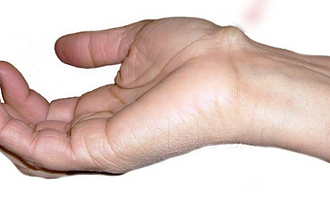

HAND SURGERY
Hand function is highly complex and requires careful assessment. Many hand conditions do not require surgery at all and I work closely with an experienced team of Hand Therapists who can offer many non-invasive treatments.
Surgery is often advised if conservative measures have failed to improve your symptoms. If surgery is necessary, I will ensure you have the safest, least invasive operation to obtain the best outcome with the least downtime.
Most of the operations I perform can be carried out under local anaesthetic (known as WALANT) or a nerve block, avoiding the risks of a general anaesthetic.
I am the Clinical Lead for Wide Awake Hand Surgery at St Thomas' Hospital and I am constantly striving to improve safety and outcomes for my patients.
Carpal Tunnel Syndrome
Carpal tunnel syndrome is due to compression of the median nerve in the wrist. The nerve runs in a tight tunnel along with tendons. Any swelling in the tunnel puts pressure on the nerve. This causes tingling in the thumb and fingers (typically sparing the little finger) often at night, pain and weakness. This is often presents itself as clumsiness or a tendency to drop things.
Dupuytren's Disease
Dupuytren’s disease is a common genetic disease which usually starts as firm nodules just under the skin in the palm. It gradually grows into tough cords which extend into the fingers causing them to bend. People affected often say it causes problems shaking hands, washing their face and getting hands into pockets.
Ganglion
Ganglion cysts are common swellings typically located around the wrist joint or finger joints or tendon sheaths. They contain a thick gel-like fluid. They often arise spontaneously or sometimes it is a result of an injury or arthritis. The majority just lead to a visible swelling, but sometimes the lump can cause discomfort and interfere with daily activities.

Trigger Finger
Trigger Finger is when a finger temporarily gets stuck in a bent position. It locks or catches, before suddenly straightening. The tendons to your fingers and thumb glide through tight tunnels called tendon sheaths which are made up of a series of pulleys. If the tendon or the pulley thickens, it is not able to glide smoothly and it gets stuck. Surgery is required if non-surgical methods such as steroid injection have not worked.
Osteorthritis
Osteoarthritis is a common condition affecting the small joints of the hand. It causes pain, swelling, stiffness and eventually deformity as joint destruction progresses. There are many things we can offer to improve pain and function, if simple oral pain killers and splints no longer help. A steroid injection into the affected joint is usually the first step in controlling pain. Surgery to the joints will be offered when more conservative measures no longer control your symptoms.

Rheumatoid Arthritis
Rheumatoid arthritis can be a disabling disease that can affect the appearance and the function of the hands. It can deform and bend finger joints abnormally making it difficult to do simple daily tasks.
Many of these problems can be helped with non-surgical therapy such as splints. However, in some situations surgery offers the best solution. I will work closely with your rheumatologist to determine the best option for you. Function and pain can be improved by removing inflamed tissue, repositioning tendons and replacing or fusing joints.

Hand Injuries
Hand injuries account for around 20% of all A&E attendances in the UK. I treat all injuries to tendons, nerves, vessels, bones and ligaments. I work closely with our hand therapists to get you back to work and daily activities as soon as it is safe to.
Following injuries to the hand, it is very common to develop scarring around the injured tissue. This leads to stiffness and limitation of movement and function. I offer a wide range of reconstructive procedures to improve function following trauma by releasing scar tissue or reconstructing areas that may have healed poorly.

Hand Tumours
A tumour may be benign (harmless) or malignant (cancerous). The majority of tumours in the hand are entirely benign and often do not cause any symptoms. They may be picked up on an xray incidentally when looking for a fracture following injury, for example. Tumours can arise from skin, muscle, bone, nerve and other highly specialised tissue within the hand. The most common tumours I treat (although rare in the general population) are giant cell tumours, enchondromas and glomus cell tumours.

Congenital Hand Differences
The formation of a baby's hand occurs very early in a pregnancy. The hand is a highly complex structure and there are a broad spectrum of abnormalities that can develop, ranging from fused fingers and extra digits to much more complex conditions affecting the entire upper limb. Most of these conditions are treated in childhood. However, as that child grows, scars from previous reconstructive surgery may become tight and restrictive, and minor adjustments may be required. In some cases, parents may choose not to put their child through surgery at a young age and wait until they are old enough to make their own decisions about treatments. I treat children and adults with these conditions.




